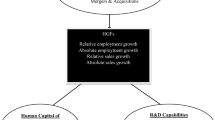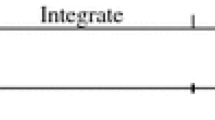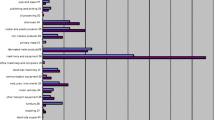Abstract
This paper empirically explores the nexus between the intensity of outsourcing by an entrepreneur and its ability to scale up in size. Intensity is measured as a continuous index to proxy for the share of jobs being contracted out. Using a non-parametric Cox proportional hazard model, the paper estimates the odds that a firm grows into a medium or large firm as a function of outsourcing intensity. Two strategies stand out. In one case, the firm contracts about 10 per cent of its workforce and doubles its chance of scaling up. In the second case, the firm contracts more than 90 per cent of its workforce and the odds go up by 2.5 times. A priori, firms in both groups are indistinct in many ways, except that firms choosing to grow with minimal outsourcing show early signs of growth. The latter firms grow to larger sizes, create more jobs, pay higher wages, and are more likely to export and conduct research. Firms growing by extreme outsourcing are only apter at surviving. Resource-based view of firms and management capability seem to be part of the explanation for the observed behavior.












Similar content being viewed by others
Data availability
Access to the data is provided by the Australian Bureau of Statistics.
Code availability
Codes are available on request.
Notes
The financial reports for these companies can be found on Google Finance and, in the case of US public companies, also on Edgar System (searching for 10-K filings).
Superannuation is the payment as a percentage of wages that employers are obligated by law to make towards their employees’ retirement. For more information see the Australian Taxation Office’s description.
A hazard function with fixed-effect dummies would have the form:
$$\begin{aligned} h_{jic}(T)=h_0(T)\times \exp (X_{jic}a+\iota _{ic})=\big (e^{\iota _{ic}}h_0(T)\big )\times \exp (X_{jic}a).\end{aligned}$$The term within the first parentheses can now be regarded as the new stratified basic hazard function as in (3). This approach is generally less computationally intensive, especially when dealing with large a dataset, than including a large number of dummies
I do a sensitivity test, using 97th and 99th percentiles to define the transition in size as opposed to 98th percentile used here. In each case, the qualitative features of the relationship and the implications stay unchanged.
References
Abraham K, Haltiwanger J, Sandusky K, Spletzer JR (2021) Measuring the Gig Economy: Current Knowledge and Open Issues. In Measuring and Accounting for Innovation in the Twenty-First Century, Edited by Carol Corrado, Jonathan Haskel, Javier Miranda, and Daniel Sichel, National Bureau of Economic Research, Massachussettes. http://www.nber.org/chapters/c13887
Abraham Katharine G, Taylor Susan K (1996) Firm’s use of outside contractors: theory and evidence. J Law Econ 14(3):394–424. https://doi.org/10.1086/209816
Alvarez Luis HR, Stenbacka R (2007) Partial outsourcing: a real options perspective. Int J Ind Organ 25(1):91–102. https://doi.org/10.1016/j.ijindorg.2006.01.003
André H (1996) On the number of clusters. Comput Stat Data Anal 23(1):83–96. https://doi.org/10.1016/S0167-9473(96)00022-9
Angaooa G, Zahir I, King-Lun C, Lionel F, Thanos P (2015) Performance measures and metrics in outsourcing decisions: a review of research and applications. Int J Prod Econ 161(1):153–166. https://doi.org/10.1016/j.ijpe.2014.12.021
Autor David H (2003) Outsourcing at will: the conbtribution of unjust dismissal doctorine to the growth of employment outsourcing. J Law Econ 21(1):1–42. https://doi.org/10.1086/344122
Barney Jay B (1991) Firm resources and sustained competitive advantage. J Manage 17(1):99–120
Barratt T, Veen A, Goods C (2021) Did Somebody Say Workers’ Rights? Three Big Questions about Menulog’s Employment Plan. The Conversation, April 15. https://theconversation.com/did-somebody-say-workers-rights-three-big-questions-about-menulogs-employment-plan-158942
Ciszewska-Mlinari M, Wasowska A (2015) Resource-Based View (RBV). Wiley Encyclopedia of Management, Volume 6: International Management, Edited by Cary L. Cooper, John Wiley and Sons, London. https://doi.org/10.1002/9781118785317.weom060174
Coase Ronald H (1937) The nature of the firm. Economica 4(16):386–405. https://doi.org/10.1111/j.1468-0335.1937.tb00002.x
Combs James G, Ketchen Jr, David J (1999) Explaining interfirm cooperation and performance: toward a reconciliation of predictions from the resource-based view and organizational economics. Strateg Manag 20(9):867–888. https://doi.org/10.1002/(SICI)1097-0266(199909)20:9%3C867::AID-SMJ55%3E3.0.CO;2-6
David H, Bilal R (2018) Firm-level analysis using the abs’ business longitudinal analysis data environment (BLADE). Aust Econ Rev 51(1):132–138. https://doi.org/10.1111/1467-8462.12253
Dube A, Kaplan E (2010) Does outsourcing reduce wages in the low-wage service occupations? evidence from janitors and guards. Ind Lab Relat Rev 63(2):287–306
Fabio P (2018) Vertical organization of production and firm growth. Ind Corp Chang 27(1):83–106. https://doi.org/10.1093/icc/dtx019
Fabio P, Zaninotto E (2013) Vertical integration and efficiency: an application to the Italian machine tool industry. Small Bus Econ 40(2):397–416. https://doi.org/10.1007/s11187-011-9367-y
Freel Mark S (2007) Are small innovators credit rationed? Small Bus Econ 28(1):23–35. https://doi.org/10.1007/s11187-005-6058-6
Grossman Gene M, Helpman E (2002) Integration versus outsourcing in industry equilibrium. Quart J Econ 117(1):85–120. https://doi.org/10.1162/003355302753399454
Grossman Gene M, Helpman E (2005) Outsourcing in a global economy. Rev Econ Stud 72(1):135–159. https://doi.org/10.1111/0034-6527.00327
Grossman Gene M, Rossi-Hansberg E (2008) Trading tasks: a simple theory of offshoring. Am Econ Rev 98(5):1978–1997. https://doi.org/10.1257/aer.98.5.1978
Grossman Sanford J, Hart Oliver D (1986) The costs and benefits of ownership: a theory of vertical and lateral integration. J Polit Econ 94(4):691–719. https://doi.org/10.1086/261404
Hall JD, Craig P, Joseph P (2018) Is uber a substitute or complement for public transit? J Urban Econ 108:36–50. https://doi.org/10.1016/j.jue.2018.09.003
Holcomb Tim R, Hitt MA (2007) Toward a model of strategic outsourcing. J Oper Manag 25(2):464–481. https://doi.org/10.1016/j.jom.2006.05.003
Judd C, Krueger Alan B (2016) Disruptive change in the taxi business: the case of uber. Am Econ Rev 106(5):177–182. https://doi.org/10.1257/aer.p20161002
Leiblein Michael J, Miller Douglas J (2003) An empirical examination of transaction-and firm-level influences on the vertical boundaries of the firm. Strat Manag 24(9):839–859. https://doi.org/10.1002/smj.340
Mark D, Timothy D (1998) Capital adjustment patterns in manufacturing plant. Rev Econ Dyn 1(2):409–429. https://doi.org/10.1006/redy.1998.0011
Nicholas B, John VR (2007) Measuring and explaining management practices across firms and countries. Quart J Econ 122(4):1351–1408. https://doi.org/10.1162/qjec.2007.122.4.1351
OECD (2020) OECD Employment Outlook 2020: Worker Security and the COVID-19 Crisis. OECD Publishing, Paris. https://doi.org/10.1787/1686c758-en
OECD (2021) OECD Employment Outlook 2021: Navigating the COVI-19 Crisis and Recovery. OECD Publishing, Paris. https://doi.org/10.1787/5a700c4b-en
Oliver H, John M (1999) Foundations of incomplete contracts. Rev Econ Stud 66(1):115–138. https://doi.org/10.1111/1467-937X.00080
Oz S, Rune S (2005) Partial outsourcing, monitoring costs, and market structure. Can J Econ 38(4):1173–1190. https://doi.org/10.1111/j.0008-4085.2005.00320.x
Peter F, Rhodes C, Kyoung-Hee Y (2019) On why uber has not taken over the world. Econ Soc 48(4):488–509. https://doi.org/10.1080/03085147.2019.1685744
Pol A, Elhanan H (2004) Global sourcing. J Polit Econ 112(3):552–580. https://doi.org/10.1086/383099
Robert G (2005) Four formal(izable) theories of the firm? J Econ Behav Organ 58(2):200–245. https://doi.org/10.1016/j.jebo.2004.09.010
Sasan B (2015) Productivity, outsourcing and exit: the case of australian manufacturing. Small Bus Econ 44(2):425–447. https://doi.org/10.1007/s11187-014-9604-2
Sasan B (2019) Entrepreneurship dynamics in australia: lessons from micro-data. Econ Rec 95(308):114–140. https://doi.org/10.1111/1475-4932.12460
Sasan B (2021) Government financial assistance as catalyst for private financing. Int Rev Econ Financ 72(1):59–78. https://doi.org/10.1016/j.iref.2020.11.003
Sasan B, Robert B, Lisa M, Jacquelyn Z (2020) Financial constraints and small and medium enterprises: a review. Econ Rec 96(315):506–523. https://doi.org/10.1111/1475-4932.12560
Stefano F (2010) Outsourcing versus integration at home or abroad and firm heterogeneity. Empiprica 37(1):47–63. https://doi.org/10.1007/s10663-009-9118-3
Thor B, Chinchih C, Benedikt FC (2018) Drivers of disruption? estimating the uber effect. Eur Econ Rev 110:197–210. https://doi.org/10.1016/j.euroecorev.2018.05.006
Williamson Oliver E (1967) Hierarchical control and optimum firm size. J Polit Econ 75(2):123–138. https://doi.org/10.1086/259258
Funding
No funding was received for conducting this study.
Author information
Authors and Affiliations
Corresponding author
Ethics declarations
Competing interests
The authors have no competing interests.
Additional information
Responsible Editor: Harald Oberhofer.
Publisher's Note
Springer Nature remains neutral with regard to jurisdictional claims in published maps and institutional affiliations.
Appendices
Robsutness tests
In this part, I present extra robustness tests for the qualitative relationship between outsourcing intensity and firm growth to make sure the qualitative features are preserved with changes to the specification. I try two variations to the specification.
First, I set the threshold for switching into medium-size at the fixed level of $2m, instead of using income quartiles, and re-estimate (3).
I also try a conventional linear model where the dependent is change in the log of turnover over the first 5 years since entry. Specifically, the model to estimate is:
in which, \(\iota\) and c denote industry and cohort dummies.
The estimated coefficients from each case are listed in Table 7. The implied relationships are illustrated in Fig. 13. Both relations still have a bimodal form, with InGrow and OutGrow groups of firms showing the highest likelihood of growth.
Disclaimer
The results of these studies are based, in part, on ABR data supplied by the Registrar to the ABS under A New Tax System (Australian Business Number) Act 1999 and tax data supplied by the ATO to the ABS under the Taxation Administration Act 1953. These require that such data is only used for the purpose of carrying out functions of the ABS. No individual information collected under the Census and Statistics Act 1905 is provided back to the Registrar or ATO for administrative or regulatory purposes. Any discussion of data limitations or weaknesses is in the context of using the data for statistical purposes, and is not related to the ability of the data to support the ABR or ATO’s core operational requirements. Legislative requirements to ensure privacy and secrecy of this data have been followed. Only people authorised under the Australian Bureau of Statistics Act 1975 have been allowed to view data about any particular firm in conducting these analyses. In accordance with the Census and Statistics Act 1905, results have been confidentialised to ensure that they are not likely to enable identification of a particular person or organisation. Views expressed in this paper are those of the author and not necessarily those of the Department of Industry, Innovation and Science or the Australian government.
Rights and permissions
About this article
Cite this article
Bakhtiari, S. Growing by outsourcing: a tale of two growths. Empirica 50, 411–439 (2023). https://doi.org/10.1007/s10663-022-09564-7
Accepted:
Published:
Issue Date:
DOI: https://doi.org/10.1007/s10663-022-09564-7





